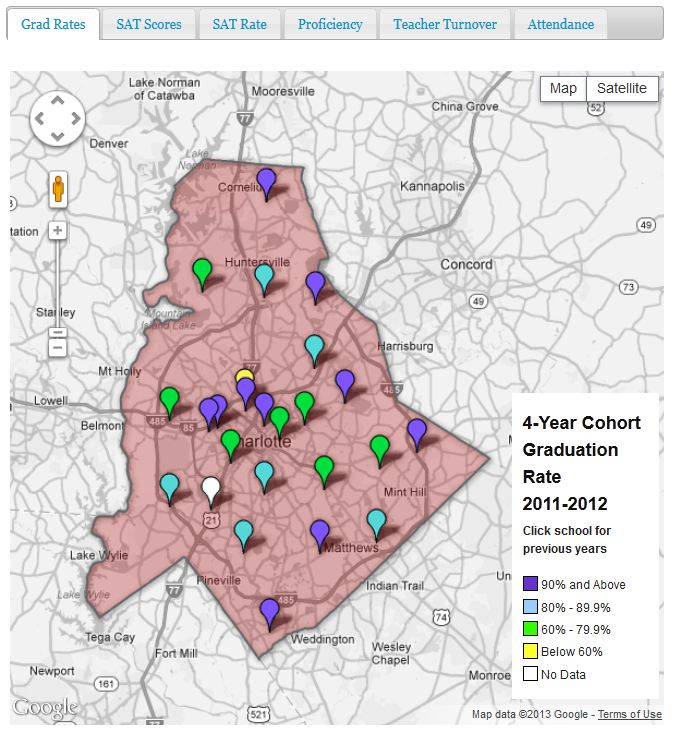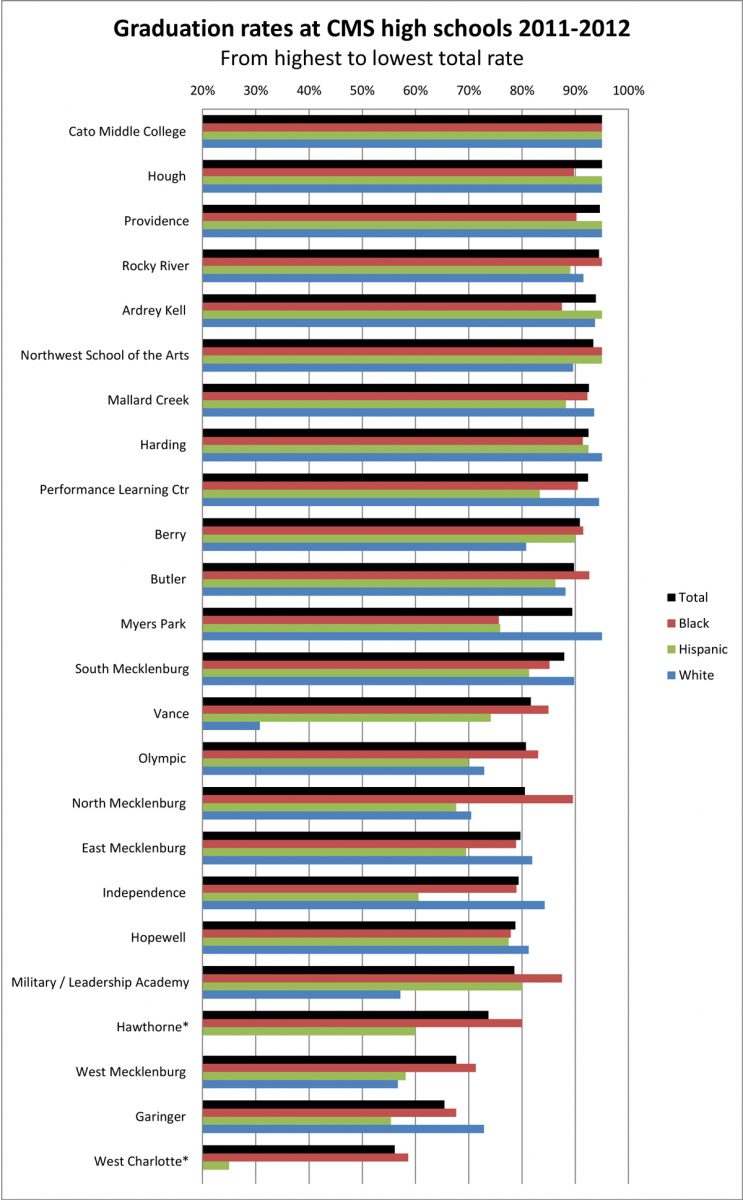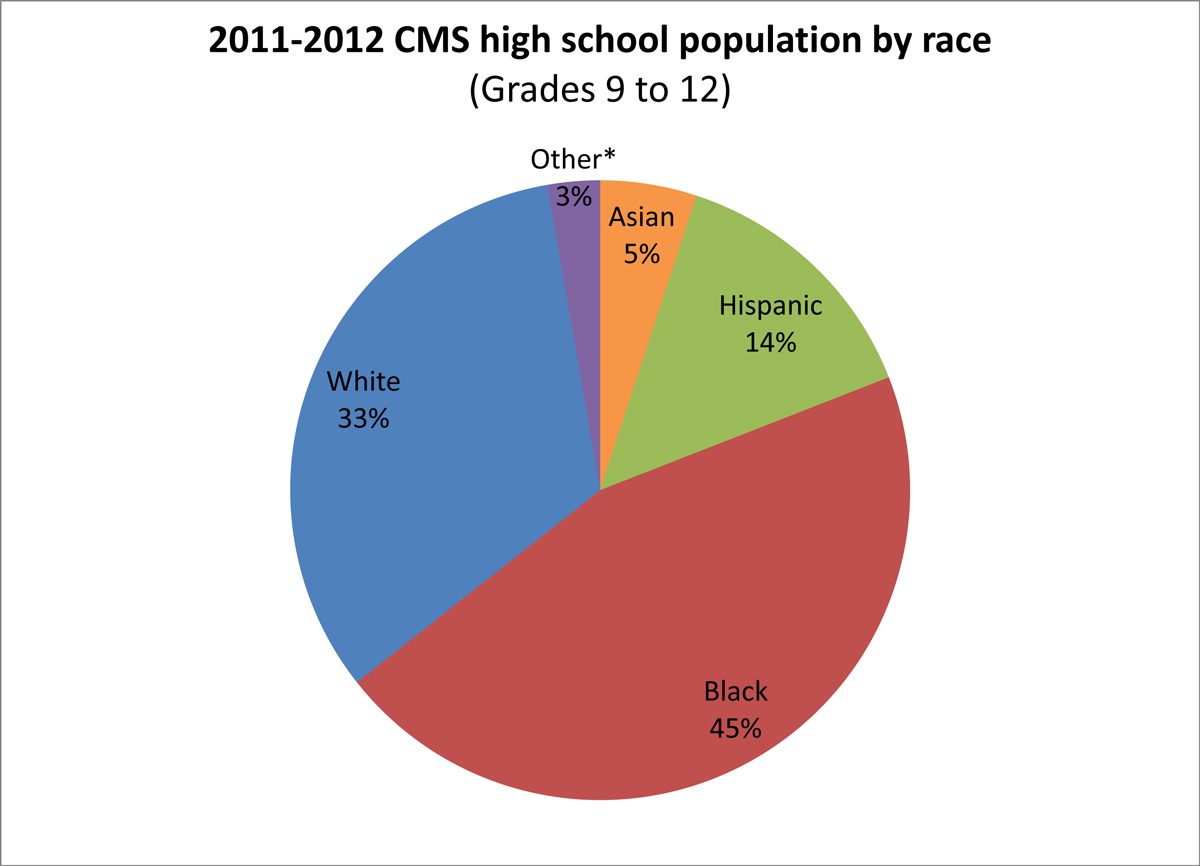Mapping CMS high school data

How well do you understand the differences between high schools in CMS? After years of rapid growth and changing demographics in Mecklenburg County, it may be time to update your perspective.
The UNC Charlotte Urban Institute has compiled interactive maps of Charlotte-Mecklenburg high schools as part of our partnership with MeckEd. With this tool, it is easy to compare schools on graduation rates, SAT scores, proficiency, teacher turnover and attendance. The image below shows the top map. Click the map image to go to the interactive maps at the bottom of this article.
 The first map, on high school graduation, shows a clear pattern of high graduation rates (90 percent or greater) in a set of in-town magnet schools (Berry, Harding (which is a partial magnet), Northwest School of the Arts, Performance Learning Center, and Cato Middle College). High graduation rates also appear in suburban schools further from the center city– Mallard Creek, Audrey Kell, Providence, Hough and Rocky River. Schools with rates of less than 80 percent fall mostly within Charlotte (with the exception of Hopewell). West Charlotte had the lowest rate in 2012 at 56 percent, but that school’s rate has moved from a 51 percent graduation rate in 2010. East Mecklenburg and Independence are other examples of a school showing progress in graduation rates, moving from around 72 percent in 2010 to nearly 80 percent in 2012. Not all schools are moving in a positive direction, however. Garinger’s graduation rate has declined from 77 percent in 2010 to 65 percent in 2012.
The first map, on high school graduation, shows a clear pattern of high graduation rates (90 percent or greater) in a set of in-town magnet schools (Berry, Harding (which is a partial magnet), Northwest School of the Arts, Performance Learning Center, and Cato Middle College). High graduation rates also appear in suburban schools further from the center city– Mallard Creek, Audrey Kell, Providence, Hough and Rocky River. Schools with rates of less than 80 percent fall mostly within Charlotte (with the exception of Hopewell). West Charlotte had the lowest rate in 2012 at 56 percent, but that school’s rate has moved from a 51 percent graduation rate in 2010. East Mecklenburg and Independence are other examples of a school showing progress in graduation rates, moving from around 72 percent in 2010 to nearly 80 percent in 2012. Not all schools are moving in a positive direction, however. Garinger’s graduation rate has declined from 77 percent in 2010 to 65 percent in 2012.
There are many factors that affect graduation rates and other measures which are beyond the control of teachers and staff in these schools. New school openings, school closures, relocations of magnet programs and underlying demographic changes in neighborhoods can all cause changes in year-to-year measures like graduation rates.
And, although these are all public schools in the same county, the demographics of schools can vary significantly. The graph below shows the high schools in order of highest to lowest graduation rate. For each school, the graduation rate by the largest racial groups within CMS (blacks, whites and Hispanics) is also shown.

This shows a complex picture of schools with different graduation rates among racial groups in some schools, and rates that are uniformly high (or low) in others. There are also examples of schools that have different profiles than were common in decades past. Mallard Creek, for example, which has a population that is 61 percent black and has a graduation rate of 93 percent. At Northwest School of the Arts, white students have a slightly lower graduation rate than black or Hispanic students (although all are high). At Northwest, the population is 39 percent white, 49 percent black, with 6 percent Hispanic population.
Another example of the evolving demographics in the county is the nearly 25 percent Hispanic population at Vance High School. The largest group at Vance is black students, which make up nearly 70 percent of the population. The graduation rate at Vance is over 80 percent.
With many students in the district, it is the minority student population that is the largest contributor to most schools’ results in measures like graduation rate or SAT scores.
The high school racial population in CMS is shown in the graph below.

The high school racial breakdown for the district matches very closely to the overall student population in the district, with the major difference being that there are more Hispanic students in lower grades, which makes the breakout for the district as a whole 17 percent Hispanic and 42 percent black (the other groups are the same for high school as for the total population).
|
For more information Similar tools are also available to view Mecklenburg charter school information. Click here to learn more. |
The interactive maps of high school data (below) also show:
- SAT scores and the percentage of students who participate in the SAT test
- A composite proficiency score that is based on the full set of “end of course” or EOC scores
- Teacher turnover rate
- Attendance rates
To further explore education data, go to the MeckEd indicator explorer page that is part of our Regional Indicators project. Together, these resources allow for in-depth exploration of education and other data. The tools display data using interactive graphs featuring regional and national comparisons.
The maps below show the locations of high schools in Mecklenburg County and provide detailed information about each school. Select the tab to choose the topic and then click on individual schools to see data related to that school. Zoom or pan within the map to get a better idea of where the schools are. If available, data from the last three years are displayed for each school. For more detailed descriptions of the definitions of each data item, as well as source information, scroll below the interactive map.
Scroll below to see an interactive map of CMS high school data.
Source: All data from the North Carolina Department of Public Instruction.
Definitions:
- Graduation Rate: The percent of students who entered 9th grade in a particular year that graduated 4 years later.
- SAT Scores: Average scores of the combined Math, Critical Reading and Writing sections of the SAT
- SAT Participation: The percentage of students taking the SAT at the school.
- Proficiency: Percent of all End-of-Course test scores (Algebra I/II, Biology, Civics and Economics, English I, History, Physical Science, and Writing) that are at or above grade level.
- Teacher Turnover: If a teacher is not employed as a teacher in the same school as they were employed as a teacher in the previous year, they are classified as turnover. Measures the percentage of teachers classified as turnover.
- Attendance: Calculated as the average daily attendance divided by the average daily membership (ADA/ADM). ADA is the total number of days attendance for all students divided by the total number of school days in a given period. ADM is the total number of school days within a given term that a student’s name is on the current roll of a class, regardless of whether the student is present or absent. The quotient of ADA/ADM has little actual variation but can be used to perform a comparison between schools as score closer to 100 has higher attendance.